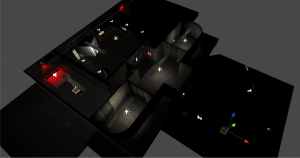The Sound of Music was the first time that I had to work both synchronously and asynchronously with a team of people. It introduced me to the use of database software (P4V, Perforce) and the concept of building a world in pieces that fit together at runtime. I also learned the importance of working as a team and creating universal assets for team to decrease complexity, increase productivity, and reduce bugs. During this project I was the PLK (Persistent Level Keeper). My duties were to make sure every team members content was included and combined together within the game world. On top of that I also had to create a portion of the game world myself. I was given the 4th and final zone in the game, the vault and its connecting subway tunnel.
In The Sound of Music you play as a scrapper, a nomad tasked with retrieving objects out in the barren wastelands. Your task is to retrieve the last known surviving piece of music from an underground vault. If you reach the vault and successfully bypass the security system keeping it locked then you will be able to listen to the only remaining piece of music in the world.
See if you can figure out the puzzle by downloading the game and playing for yourself.
Music provided by Thomas Gaff.
Screenshots provided are of areas of my personal creation only. The game was a four person team project. Each team member was responsible for a single area of the world. I was responsible for the area immediately surrounding the final objective affectionately known as “the vault”.
During this project we were provided with the vast majority of the assets used to create the game world. But in order for the vault to feel alive I ended up having to develop some assets of my own design. The most notable of the assets I created are the computer screens seen throughout the level. I wanted the screens to respond to player input and so I had to write scripts governing the interactions and changes in state that the screen would go though. Because the original asset only had a blank black screen on it I also had to create the individual screen images myself. In the second image the large screen in the center is interactive and it provides the player with hints required to get the power in the area up and running. The smaller screens are physics objects that the player can pickup and throw. The text on the smaller screens was programmed to scroll up slowly as if the system was running processes in the background. Taking it a step further I decided to add a collision exception to the object that would cause the computer screen to go blank if the player removed it from the desk area. This provided the illusion that the player had broken or unplugged the screen which aided in the immersion of the environment.
At the bottom of the first image you can see water and sparks. Both were created by me and were interactive. The water in this image is being electrified by a conduit inside the broken wall. While it is not completely visible in this image the ground that contains the water was actually a small terrain asset I created to allow the water to meet the cube based geometry of the floor with a smooth and varied transition.
Finally, I created timed audible sound effects throughout the world. The best way to experience it is to play it for yourself. l encourage anybody interested in this project to take a peek at the game and let me know what you think.
-Matt
Check out the trailer!












